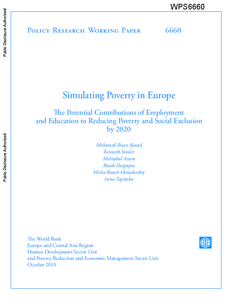Simulating poverty in Europe: the potential contributions of employment and education to reducing poverty and social exclusion by 2020
"This paper sheds light on the impact of improving employment and education conditions on poverty and social exclusion indicators. More specifically, it answers the following question: Will achieving the Europe 2020 national targets on employment and education lead countries to achieve the Euro...
| Main Authors: | , , , , , |
|---|---|
| Institution: | ETUI-European Trade Union Institute |
| Format: | TEXT |
| Language: | English |
| Published: |
Washington, DC
2013
World Bank |
| Subjects: | |
| Online Access: | https://www.labourline.org/KENTIKA-19123033124919412159-Simulating-poverty-in-europe-t.htm |
| Summary: | "This paper sheds light on the impact of improving employment and education conditions on poverty and social exclusion indicators. More specifically, it answers the following question: Will achieving the Europe 2020 national targets on employment and education lead countries to achieve the Europe 2020 poverty and social exclusion target with no other policy interventions? The paper presents a simple partial equilibrium model that is flexible enough to be implemented in a number of different settings and uses widely available household survey data. The simulation model analyzes poverty and social exclusion outcomes in response to changes in education completion rates and employment rates. The model is applied to ten of the European Union's new Member States -- Bulgaria, the Czech Republic, Estonia, Hungary, Latvia, Lithuania, Poland, Romania, Slovakia, and Slovenia -- and the model's performance is evaluated through a validation exercise. The Europe 2020 national employment targets are ambitious in many of the new Member States, given historical employment patterns in the countries. Especially in light of the slow and uncertain recovery, labor markets remain weak and employment rates in 2020 could fall short of rates targeted by national policy makers. In this eventuality, the poverty and social exclusion goals may not be reached in many of the new Member States without additional policy measures." |
|---|---|
| Physical Description: | 1 v. Digital |

